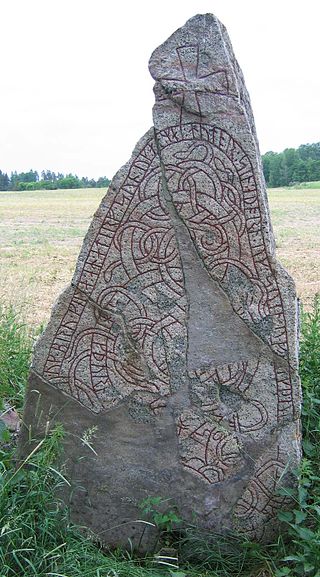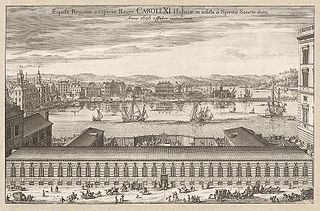Related Research Articles

Gustaf V was King of Sweden from 8 December 1907 until his death in 1950. He was the eldest son of King Oscar II of Sweden and Sophia of Nassau, a half-sister of Adolphe, Grand Duke of Luxembourg. Reigning from the death of his father Oscar II in 1907 to his own death nearly 43 years later, he holds the record of being the oldest monarch of Sweden with the third-longest reign after Magnus IV (1319–1364) and his great-grandson, Carl XVI Gustaf (1973–present). He was also the last Swedish monarch to exercise his royal prerogatives, which largely died with him, although they were formally abolished only with the remaking of the Swedish constitution in 1974. He was the first Swedish king since the High Middle Ages not to have a coronation and so never wore the king's crown, a practice that has continued ever since.
The Swedish alphabet is a basic element of the Latin writing system used for the Swedish language. The 29 letters of this alphabet are the modern 26-letter basic Latin alphabet plus ⟨å⟩, ⟨ä⟩, and ⟨ö⟩, in that order. It contains 20 consonants and 9 vowels. The Latin alphabet was brought to Sweden along with the Christianization of the population, although runes continued in use throughout the first centuries of Christianity, even for ecclesiastic purposes, despite their traditional relation to the Old Norse religion. The runes underwent partial "latinization" in the Middle Ages, when the Latin alphabet was completely accepted as the Swedish script system, but runes still occurred, especially in the countryside, until the 18th century, and were used decoratively until mid 19th century.
Nordisk familjebok is a Swedish encyclopedia that was published in print from between 1876 and 1993, and that is now fully available in digital form via Project Runeberg at Linköping University. The public domain editions of the encyclopedia remain important reference works in Finland, especially on Finnish Wikipedia.

Stig Halvard Dagerman was a Swedish author and journalist prominent in the aftermath of World War II.

Blot-Sweyn was a Swedish king c. 1080, of disputed historicity, who was said to have replaced his Christian brother-in-law Inge as King of Sweden, when Inge had refused to administer the blóts at the Temple at Uppsala. There is no mention of Sweyn in the regnal list of the Westrogothic law, which suggests that his rule did not reach Västergötland. According to Swedish historian Adolf Schück he was probably the same person as Håkan the Red and was called the Blót Swain as an epithet rather than a personal name.

Falkenberg is a locality and the seat of Falkenberg Municipality, Halland County, Sweden, with 27,813 inhabitants in 2019. It is located at the mouth of river Ätran. The name consists of the Swedish words for falcon (falk) and mountain (berg). Falkenberg is a popular tourist destination in the summers, and the main beach of the town is Skrea strand.

Älvkarleby is a locality situated in Älvkarleby Municipality, Uppsala County, Sweden with 1,647 inhabitants in 2010. It is not the seat of the municipality, a function held by Skutskär 7 km to the north.
Swedish literature is the literature written in the Swedish language or by writers from Sweden.
Laurie Thompson was a British academic and translator, noted for his translations of Swedish literature into English.
The Lord High Steward or Lord High Justiciar was a highly prominent member of the Swedish Privy Council from the 13th century until 1809, excluding periods when the office was out of use.

Norstedts Förlag is a book publishing company in Sweden. Norstedts is Sweden's oldest publishing house and one of the largest in the country. It was founded in 1823 by Per Adolf Norstedt, under the name P. A. Norstedt & Söner.

Britt Inger Liselott "Lotta" Lotass Hagström is a Swedish writer. She holds a PhD of Comparative literature from the University of Gothenburg, and lives in Gothenburg, Sweden.

Walter Magnus Runeberg was a Finnish neo-classical sculptor. He was the son of Finnish national epic poet Johan Ludvig Runeberg.

Events from the year 1696 in Sweden

To Kill a Child is a 2003 Swedish-Finnish short drama film written and directed by Alexander Skarsgård and Björne Larson, and based on Stig Dagerman's novella Att döda ett barn.

Etta Federn-Kohlhaas or Marietta Federn, also published as Etta Federn-Kirmsse and Esperanza, was a writer, translator, educator and important woman of letters in pre-war Germany. In the 1920s and 1930s, she was active in the anarcho-syndicalist movement in Germany and Spain.
Gunhild Kyle was a Swedish historian. She was Sweden's first professor of women's history at the University of Gothenburg.

A Burnt Child is a novel by the Swedish author Stig Dagerman, published in 1948.

Björkborn Manor is a manor house and the very last residence of Alfred Nobel in Sweden. The manor is located in Karlskoga Municipality, Örebro County, Sweden. The current-standing white-colored manor house was built in the 1810s, but the history of the property is older.
References
- ↑ "Like It Never Was Before". 14 March 1995.